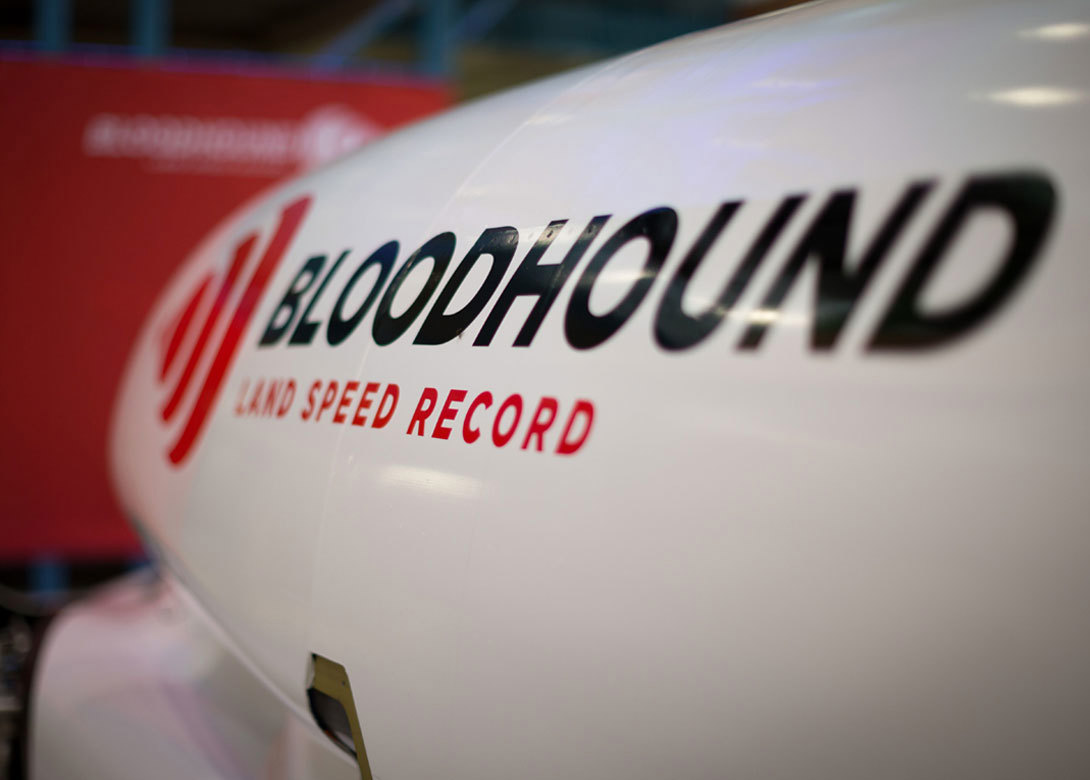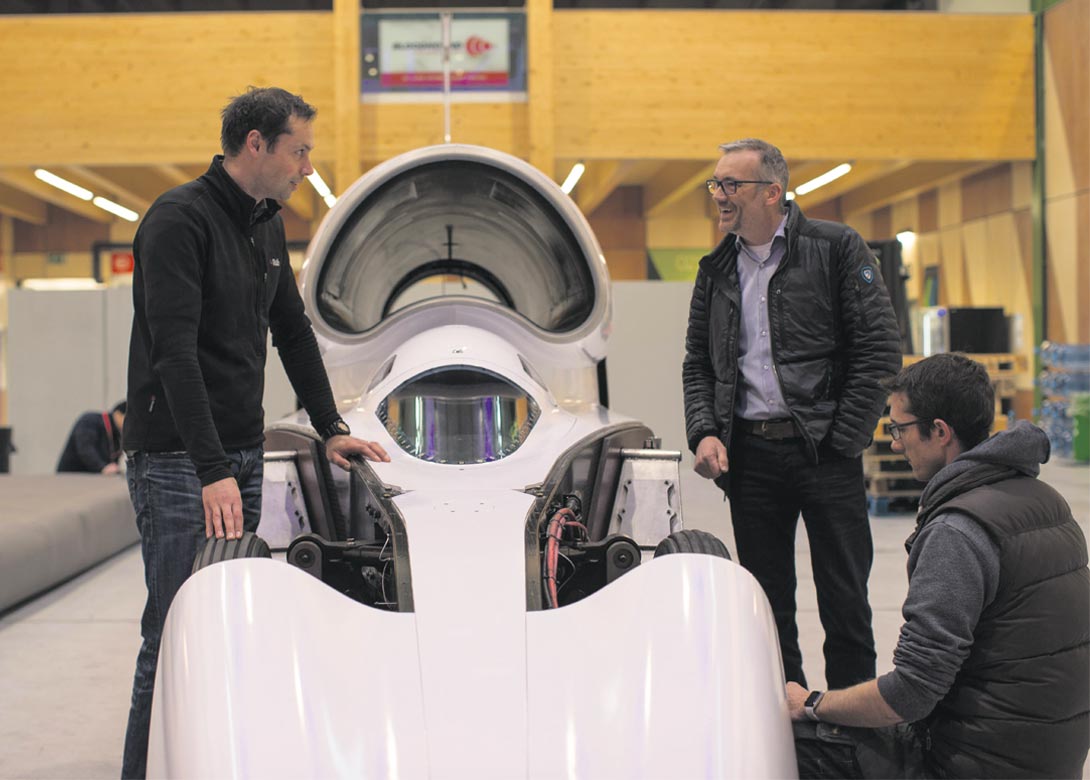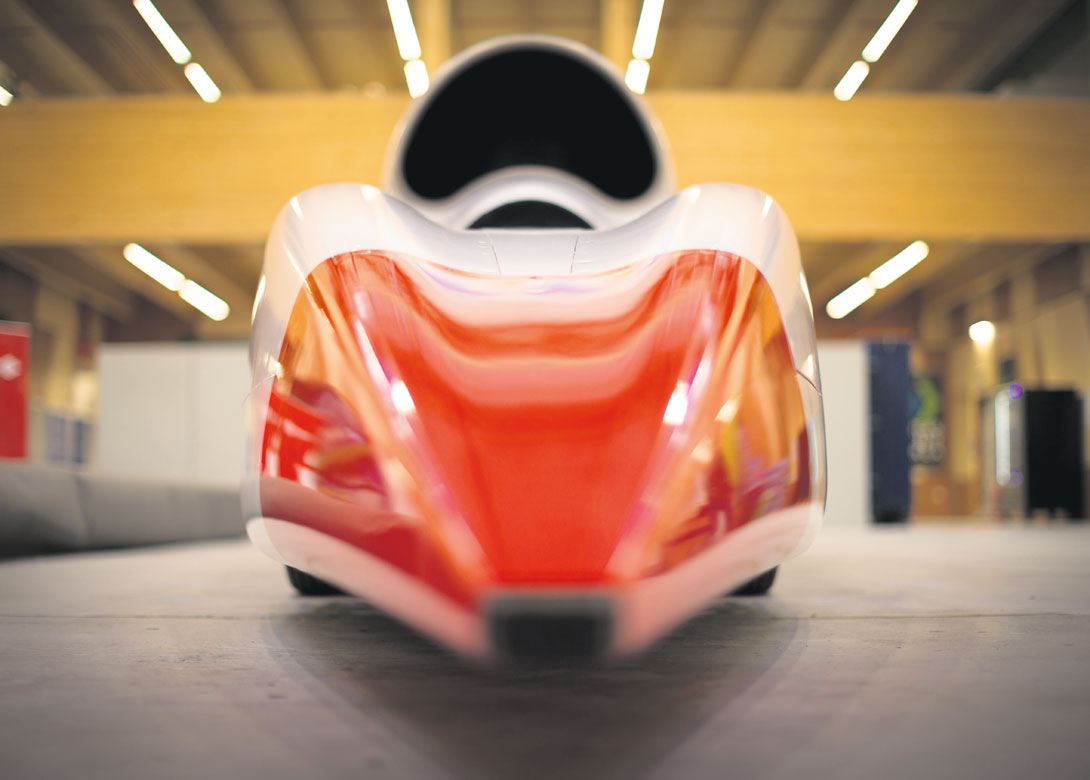
By Ian Parker, freelancer, Ianfliesrussian@aol.com
Why would anyone want to drive a car at 1,000mph (1,609km/h)? The best answer is probably by President Kennedy, who when asked ‘why would anyone want to go to the Moon?’, said: “We choose to do these things, not because they are easy, but because they are hard.”
The world is full of problems, so why create a new one that seems to have no practical value such as being the first car to travel over 1,000mph? It’s all to do with human nature and stimulating young people. Also, it does have huge technical value, though it might not be that apparent straightaway.
New investment
At the end of 2018, things looked pretty bleak for the Bloodhound SSC Land Speed Record (LSR) project. Breaking a land speed record has never been easy, particularly if the goal is to clear 1,000mph (1,609km/h). You need a highly engineered car, a rigorous test programme, and a suitable bit of land upon which to run it – somewhere flat and remote enough for the neighbours not to mind, but convenient enough that you don’t have to also build a bunch of new roads to get there. Bloodhound LSR found such a place in the Hakskeen Pan in South Africa. However, by October 2018, the project entered into administration when it ran out of funding. By December, with no buyer found, it looked like the dream was over.
That has all now changed. Bloodhound LSR has a new backer in Ian Warhurst, who bought the assets from the administrators at the end of last year. It’s also got a new HQ, with the car moving from its former base in Bristol, UK, to SGS Berkeley Green University Technical College (UTC) on the Gloucestershire Science and Technology Park.
“Since buying Bloodhound from the administrators last December, the team and I have been overwhelmed by the passion and enthusiasm the public have shown for the project. Over the last decade, an incredible amount of hard graft has been invested in the project and it would be a tragedy to see it go to waste,” Warhurst said. “Starting with a clean slate, it’s my ambition to let Bloodhound off the leash and see just how fast this car can go. I’ve been reviewing the project and I’m confident there is a commercial business proposition to support it. I’ll provide robust financing to ensure there is cashflow to hit the high-speed testing deadlines we set ourselves.”
RAF Wing Commander Andy Green will still be Bloodhound’s driver, and many from the original team have also made the transition from Bloodhound SSC to Bloodhound LSR. The most noticeable change? A bright new coat of paint. The old blue and orange livery is no more; now it’s a white and red affair. This may change, though, as the plan is to offer title branding opportunities to potential sponsors to raise the sufficient funds to actually take the car to South Africa and run it for a record-breaking attempt.

The importance of 1%
A key part of running a Land Speed Record car is being able to stop it. Bloodhound will have a truly huge amount of energy at 1,000mph – about 660 Mega Joules. To put that in perspective, a high-speed train, blasting along at 125mph, has about 560 Mega Joules of energy – 100 less than Bloodhound. It’s enough energy to boil over 300,000 kettles, so it’s a safe bet that they can’t stop the car with wheel brakes alone.
Project aerodynamicist and performance expert, Ron Ayers, has calculated that about 52% of Bloodhound’s energy will be absorbed by aerodynamic drag, 36% will be absorbed by the airbrakes (and/or drag chutes) and 11% will be dissipated by the vehicle’s rolling resistance. That makes 99%. The remaining 1% will be absorbed by the car’s wheel brakes.
If the wheel brakes are only going to absorb a measly 1% of the energy, then why are they even bothering to fit them? Well, partly because they were needed for the UK runway tests at the Newquay Aero Hub, where the brakes had to do most of the work. For the runway runs, Bloodhound had brakes on all 4 wheels, with dual circuits, to give lots of stopping power and redundancy. The runway at Newquay is 2,700m (9,000 ft) long, which is huge until you’re doing over 200mph in a 6 tonne car – then it’s not quite so huge anymore. They used carbon-carbon brakes, the same as those used by aircraft and high performance race cars, to give the best braking performance on the runway.
On desert operations, the brakes are less important, as they are only doing 1% of the work. It’s an important last bit though. There’s no point in getting 99% of the braking done and then trundling off the end of the Hakskeen Pan at 50mph – that would just be embarrassing. The wheel brakes will shorten the stopping distance by about half a mile and they will also let the driver slow the car down to walking speed, turn it through 180 degrees and stop right next to the turn-round crew. The FIA Land Speed Record regulations require two runs in opposite directions, within one hour, so turning round and stopping in exactly the right place is a key part of it.
There is a problem with wheel brakes on the desert, though. The driver won’t need to use them at 1,000mph, but they will still be along for the ride, at over 10,000rpm (that’s 170 revolutions per second). The team tested a carbon fibre brake disc at 10% above this spin speed, to give a safety margin – the disc exploded. This carbon disc was one of the best in the world, the same specification as the RAF’s new Typhoon jet uses. “We already knew that no jet fighter has ever flown at 1,000mph at ground level, and now we know their brakes won’t survive it either. We needed another solution.” said Ron Ayers.
The proposed alternative is an unusual one, using steel discs. No one uses steel for brake discs. Steel doesn’t absorb as much energy as carbon and it can be damaged by the extreme heat that race car brakes experience. Steel does have one key advantage though – it’s stronger than a carbon disc. Steel will survive the extreme loads at 1,000mph, but the question is, will it survive exposure to 1% of Bloodhound’s huge amount of energy?
To test the steel brake discs, the team went to AP Racing, where the rest of brake assembly has been made. “We cranked their rig up as fast as it could go, which equates to around 160mph for Bloodhound. The test team did 10 full stops from maximum speed on the same steel disc. Maximum temperature on the disc was around 1,100ºC, roughly the same temperature as the inside of a volcano. Harsh conditions for a brake disc,” said Ayers.
“The good news is that the aluminium brake calliper (the fixed bit that holds the pads and brake mechanism) only hit 150ºC, so no problems there. The final bits of the test are to conduct a metallurgical analysis of our super-heated steel disc, to check it’s still OK, and then spin it up to over 10,000rpm (simulating over 1,000mph) to make sure it can still cope. Once it survives all of that, then we have found our desert wheel braking solution. It’s only 1%, but it’s an important 1%.”

All about the details
Travelling at 1,000mph brings some other interesting challenges. Driver Andy Green explains: “To get into the cockpit, I will climb down through an oval canopy hatch positioned on the top of the cockpit. This area is subject to very low pressure at supersonic speeds, as the air accelerates over the cockpit, and this low pressure will try to tear the cockpit hatch off the car. At supersonic speeds, that will make my 1,000mph 'office' more than a little windy. The hatch would then immediately be eaten by the EJ200 jet engine, destroying both hatch and engine, which is also not ideal.”
“To make sure that the hatch stays on, our stress expert Roland has put a lot of work into making sure that the canopy latches are strong enough. The finished result has just been delivered and looks great. The latch doesn’t look much, but it’s stressed to a normal working load of 2.5kN (quarter of a tonne) – that’s three large guys hanging off this little handle all at the same time.”
“Just behind the ‘office’, the HTP tank (containing one tonne of rocket oxidiser) needs to slot into the carbon fibre monocoque. The rocket will burn off the whole one tonne load of HTP in a little over 20 seconds, at the centre of the car, to make sure that the vehicle’s centre of gravity doesn’t move too much. This will put the HTP tank directly behind my cockpit, but I’ve been promised there are lots of bulkheads and seals to prevent the HTP joining me in the cockpit at any stage.”
“Meanwhile, the tank has now had its first test-fit inside the monocoque. It’s snug, but it all fits nicely, and we can reach all the key points to install the plumbing and to service it.”
The front suspension is also coming along well, with AMRC completing the upper section and now working on the lower parts. “They look simply stunning and I can’t wait to see them all on the car,” says Green. Each upper section was machined from a forged block of aerospace grade aluminium, provided by thyssenkrupp Materials, measuring the size of a coffee table and weighing 300kg. After 180 hours of machining, the upper suspension item now weighs just 18kg, with over 280kg of material to be recycled for next time.
“This phase of Bloodhound’s engineering is all about details. Any mistakes we make now will cost us dear, when we get to the desert in South Africa next year. If we’re going to have a world-class engineering adventure, and push the boundaries of physics at 1,000mph, and do it all safely, then we need to get the details right first time. It’s a fascinating process to watch, as it all starts to come together,” says Green.
“We are still putting the funding together for our record attempts and we have recently lost a couple of key suppliers. We still haven’t sourced replacements for the parts and, with time running out, we’ve finally had to accept a delay.”
“We have rescheduled for the second quarter of next year, rather than go later this year. While it’s a little frustrating to have to wait for another 9 months, it’s a slightly cheaper way of doing the test runs, as it reduces the time (and set-up costs) between ‘Bloodhound 500’ and the supersonic record runs late next year. The delay also gives us more time to prepare the car and, from my point of view as the driver, that’s a good thing,” says Green.
“With more time to get the car ready, we are now aiming to build a slightly different vehicle for next year’s runs. Instead of a 500mph jet car for this year, which we would then upgrade to a jet-plus-rocket supersonic system for next year, we are already starting to prepare the supersonic Car. ‘Bloodhound 500’ will be our 500mph jet-only test session next spring with this vehicle, then we’ll simply ‘plug in’ the rocket and target a new World Land Speed Record in the autumn. Our rocket team is going to hate me for saying ‘simply plug in the rocket’ – yes, it really is rocket science and no, it’s not simple, but you know what I mean.”
There are many technical innovations on Bloodhound, but perhaps the little noticed ones are the fasteners that keep the whole thing together. The car has about 3,500 bespoke components with more than 15,000 rivets in the rear section alone. All of them must do their job 100% if the run is to be a success.
For instance, the ‘slow-speed’ bodywork that was fitted for the 200mph test runs last year is also now being modified for high-speeds. To do this, the Bloodhound build team has been hard at work adding the composite body panels to the rear sub assembly – drilling almost 100 holes, by hand, with millimetre accuracy to seat the ‘top hats’.
Top hats are inserts that spread the load from each fixing point into the composite panels. They are cylindrical in shape with a circular flange at one end – in other words, shaped just like a top hat. Given the huge acoustic loads and aerodynamic buffeting that the rear bodywork will suffer, these little load-spreading devices are an essential part of keeping the back of the car in one piece.

Don't have an account? Sign Up
Signing up to FastFixTechnology.com enables you to manage your account details.